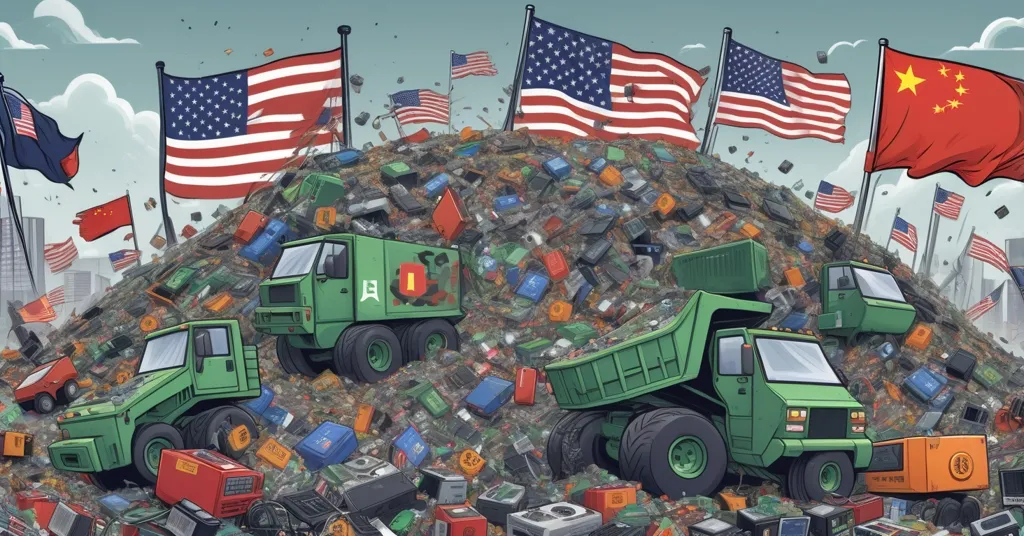E-Waste Wars: U.S. Battles China for Rare Earths in Crypto and Tech Supply Chains

Battery and Hard Drive Waste: The New Geopolitical Battleground for Crypto and Critical Metals
The United States is waging a high-stakes war over discarded electronics, EV batteries, and old hard drives, unearthing a goldmine of rare earth metals and critical materials amid escalating tensions with China. With Beijing flexing its muscle over 90% of the global rare earth supply and slapping export curbs, recycling electronic waste (e-waste) has become a strategic lifeline for everything from military tech to Bitcoin mining rigs.
- Geopolitical Strain: U.S. ramps up recycling to dodge China’s chokehold on rare earths with recent export restrictions.
- E-Waste Epidemic: 62 million metric tons generated globally in 2022, yet the U.S. recycles just 15-20% of its 8 million-ton share.
- Crypto Connection: Bitcoin mining hardware adds to the e-waste pile, while blockchain offers transparency solutions for recycling.
The E-Waste Crisis: A Mountain of Untapped Value
Let’s face the ugly truth: we’re drowning in electronic trash. In 2022, the world produced a staggering 62 million metric tons of e-waste—discarded gadgets like smartphones, laptops, and batteries—an 82% spike since 2010. The U.S. alone tossed out nearly 8 million tons, but here’s the kicker: only 15-20% of it gets recycled. That’s a colossal waste of resources when you consider what’s buried in those piles—metals like neodymium (used in powerful magnets for electric motors and hard drives), lithium (key for batteries), copper, and gold. These aren’t just shiny trinkets; they’re the lifeblood of industries ranging from military fighter jets and healthcare MRI machines to renewable energy wind turbines and consumer tech, as detailed in this report on e-waste becoming a battleground.
Now, zoom into the crypto space, where e-waste hits close to home. Bitcoin mining hardware—those specialized ASICs (Application-Specific Integrated Circuits) and GPUs (Graphics Processing Units) designed to crunch numbers for blockchain validation—often become obsolete within 1-3 years due to skyrocketing energy costs or newer, faster models. A single ASIC rig can cost upwards of $5,000 and get shelved faster than a bad NFT project, adding to the junk heap. Recycling these could recover valuable metals from circuit boards, but it’s a drop in the bucket compared to the broader crisis. Think about it—enough e-waste to bury cities, and we’re barely scratching the surface. Why the hell aren’t we doing more?
Geopolitical Chess: U.S. vs. China Over Rare Earths
Here’s where it gets messy. China controls 90% of the global rare earth market—mining, refining, processing, you name it. That’s a stranglehold on materials critical for high-tech and green industries. In April 2025, Beijing tightened the screws with export restrictions on rare earth magnets, a direct retaliation to President Trump’s tariffs, including a brutal 50% levy on copper that sent prices through the roof. The fallout was immediate: automakers like Ford shuttered factories over magnet shortages, and industries from military to consumer tech felt the burn, as highlighted in recent updates on China’s export curbs impacting U.S. supply chains. Even a June 2025 U.S.-China deal to resume flows hasn’t unclogged the pipeline, with inventory backlogs and bureaucratic snags keeping supply chains in limbo.
The U.S. government isn’t sitting idle. The Pentagon has grabbed a hefty equity stake in MP Materials, the only American outfit currently mining rare earths, on top of $45 million in prior funding under Biden. The Interior Department also approved the Colosseum rare earth project in California’s Mojave National Preserve, potentially a second U.S. mine, though it’s owned by Australia’s Dateline Resources and won’t deliver for years. New mining projects take decades to scale, often bogged down by environmental red tape and massive costs. Recycling, on the other hand, is the quick and dirty fix—tapping into existing mountains of e-waste to bypass China’s grip without waiting for a shovel to hit dirt. For a deeper dive into these materials, check this overview of rare earth mining and recycling.
Recycling Boom: Big Bets and Bigger Risks
The numbers don’t lie—the U.S. e-waste recycling market pulled in $28.1 billion last year, growing at a steady 8% annually. It’s a frenzy fueled by both policy muscle and private sector cash, as outlined in this report on U.S. e-waste market growth. Global giant Glencore processes 15% of its feedstock from e-waste at a Quebec smelter and dumped $327.5 million into Li-Cycle, a Toronto-based battery recycler that spectacularly crashed into Chapter 15 bankruptcy by May 2025. Glencore’s now circling with a $40 million bid for its assets, with more details available in this update on Li-Cycle’s bankruptcy proceedings. Meanwhile, Cyclic Materials is sinking over $20 million into a new plant in Mesa, Arizona, and German firms like Wieland and Aurubis are betting big with facilities in Kentucky ($100 million) and Georgia ($800 million), respectively. As Aurubis CEO Toralf Haag put it:
“Aurubis Richmond will allow us to keep strategically important metals in the economy.”
EV battery recycling is another hot spot, with companies like Ascend Elements and Redwood Materials chasing lithium, cobalt, and nickel from spent packs. Hard drive recycling is picking up too—startups like Illumynt and partnerships between Western Digital and Microsoft are extracting rare earths from decommissioned drives, balancing data security with resource recovery. Dave Daily, CEO of Full Circle Electronics, noted the surge: “We’re definitely seeing a bit of an influx of [e-waste] coming into our warehouses.”
But buckle up—this recycling ride’s got potholes everywhere. Glencore’s Kunal Sinha throws cold water on the hype, warning:
“Be careful not to build a recycling company on the back of one tax credit, because it can be short-lived.”
He’s pointing at incentives like the 45X tax credit, a lifeline for battery recyclers that could get axed under Trump’s spending cuts. Sinha’s blunt advice to investors? “Don’t invest on the hype, but on the fundamentals.” Li-Cycle’s collapse, despite massive backing, is a neon warning sign. Turns out, betting big on e-waste isn’t always a golden ticket—sometimes it’s just a pricey dumpster fire. John Mitchell from the Global Electronics Association sees a silver lining in tariffs, saying, “There’s a great opportunity to actually have the tariffs be an impetus for greater recycling in this country.” Maybe, but the jury’s still out on whether this boom can outrun policy flip-flops and speculative bubbles.
Crypto’s Stake: Mining Hardware and Rare Earth Ripples
Let’s talk Bitcoin and crypto, because this e-waste mess isn’t just a geopolitical soap opera—it’s personal for miners. Rare earth shortages and skyrocketing metal prices, like copper hitting all-time highs, jack up the cost of manufacturing mining rigs. Those tiny magnets and chips in ASICs and GPUs rely on materials China’s hoarding. If supply chain snarls persist, expect pricier hardware, delayed shipments, or miners stuck with inefficient, power-guzzling relics. That’s a direct hit to Bitcoin network growth, especially for small-scale operators already squeezed by energy costs and halving events slashing block rewards, a concern echoed in discussions about Bitcoin mining hardware’s e-waste impact.
Then there’s the sustainability angle. Bitcoin mining catches enough flak for its energy footprint—now imagine the optics of discarded rigs piling up as toxic e-waste. Industry estimates suggest a single large mining farm can cycle through thousands of units every few years, contributing tons of scrap. Recycling could recover copper and gold from these boards, but the process itself, like smelting, guzzles energy not unlike mining itself. It’s a vicious cycle unless we push for greener methods, such as hydrometallurgy over traditional fire-and-fury refining. Just as Bitcoin miners are nudged toward renewables, the recycling game needs its own eco-overhaul to align with any claim of responsibility, with insights available in this analysis of Bitcoin mining sustainability.
Blockchain’s Edge: A Decentralized Fix for Recycling Woes
Here’s where our love for decentralization shines. Blockchain tech could be a game-changer in tackling e-waste transparency. Platforms like Circularise already use decentralized ledgers to track materials across supply chains, ensuring ethical sourcing and verifying recycled metals’ origins. Imagine a system where Bitcoin miners log their discarded hardware on a blockchain, earning tokenized credits for recycling while proving compliance with environmental standards. Or picture Ethereum smart contracts automating payments to recyclers only when verified e-waste is processed, cutting out shady middlemen and scams.
This isn’t pie-in-the-sky dreaming—it fits our ethos of disrupting centralized control. If we’re serious about effective accelerationism, speeding up innovation to solve real problems, then blockchain for recycling supply chains is a no-brainer. It’s not Bitcoin’s core mission, sure—BTC remains the ultimate tool for financial sovereignty—but altcoins and niche protocols can fill gaps in supply chain integrity. Sinha himself hinted at growth potential, saying, “The current environment will lead to more startups and investments. We are investing ourselves.” Why not steer some of that toward crypto-adjacent tech with real-world impact?
The Dark Side: Recycling Isn’t a Magic Bullet
Before we get too starry-eyed, let’s play devil’s advocate. Recycling sounds noble, but it’s not without baggage. Smelting and refining old electronics burn through energy, spewing carbon and sometimes toxins if not tightly regulated—hardly the green savior it’s hyped as. Then there’s the risk of scam artists and fly-by-night startups riding the e-waste wave for quick VC cash, only to fold like Li-Cycle. We’ve seen this in crypto with countless rug pulls and shitcoins; the recycling space isn’t immune to grifters either.
Plus, can it even scale to dent China’s dominance? Experts like David Abraham from Boise State University warn that China’s export license red tape signals a permanent shift, not a blip, potentially consolidating their industry for tighter control. Recycling millions of tons of e-waste annually might grab headlines, but it won’t fully close the rare earth gap if domestic demand—for EVs, military, or mining rigs—keeps exploding. For a broader perspective on this issue, see this discussion on China’s rare earth dominance in global tech. And if tax credits vanish, as Sinha fears, many of these shiny new plants could shutter overnight. We’re all for disrupting the status quo, but swapping reliance on China for reliance on shaky subsidies isn’t the freedom we’re fighting for.
What’s Next for E-Waste, Crypto, and Resource Wars?
Recycling e-waste could be our fast track to resource independence, but only if we ditch centralized crutches like fleeting tax handouts and build truly resilient, decentralized systems—starting with blockchain traceability. For Bitcoiners, the stakes are double: rare earth shortages threaten mining hardware costs, while discarded rigs pile up as another environmental headache. Let’s solve both with tech we already champion, pushing innovation at breakneck speed without swallowing every hyped-up promise. The geopolitical chessboard isn’t static—China’s internal struggles with export losses and domestic EV price wars might crack open negotiation windows, but the U.S. can’t bank on that. No bullshit: mining value from our literal trash is a start, but eyes wide open, folks. Fundamentals over fantasy, always, especially when considering the broader tensions over rare earth metals and recycling.
Key Takeaways and Burning Questions on E-Waste and Crypto Tech
- What’s fueling the U.S. drive for e-waste recycling?
It’s a mix of geopolitical heat with China, who dominates 90% of rare earths and curbed magnet exports in 2025, plus the need for critical metals in military, EV, and tech sectors, pushing the U.S. to mine its 8 million tons of yearly e-waste. - How big is the e-waste problem, especially for crypto?
Globally, 62 million metric tons hit the dump in 2022, with the U.S. recycling just 15-20% of its share; Bitcoin mining hardware like ASICs adds to this mess, piling up after short 1-3 year lifecycles and mirroring the industry’s sustainability heat. - Can recycling cut U.S. dependence on China for critical materials?
It’s faster than new mining, which takes decades, but over-reliance on tax credits like 45X and investment hype—think Li-Cycle’s bankruptcy—means it’s no sure bet without rock-solid fundamentals. - How can blockchain help with e-waste recycling?
Decentralized ledgers can track recycled metals for transparency, ensuring ethical practices and cutting scams—perfect for Bitcoin miners logging hardware disposal or broader supply chain integrity, aligning with our push for decentralization. - Are government policies a boon or bane for recycling efforts?
Moves like Pentagon stakes in MP Materials and tariffs spark action, but looming cuts to credits under Trump’s plans breed uncertainty, risking the collapse of recycling startups banking on handouts. - What’s the risk of rare earth shortages for Bitcoin miners?
Shortages drive up costs for mining rig components reliant on magnets and metals, potentially slowing Bitcoin network growth and squeezing small miners already battling energy costs and halving cycles.



